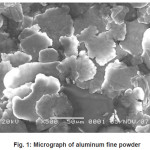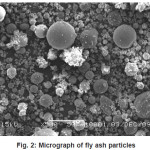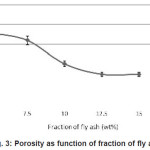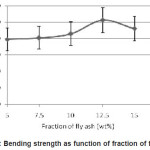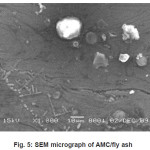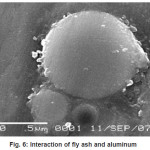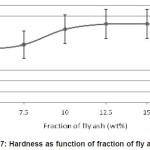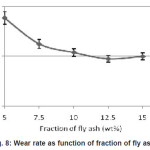Subarmono, Jamasri, M. W. Wildan and Kusnanto
Gadjah Mada University, Yogyakarta, Indonesia.
DOI : http://dx.doi.org/10.13005/msri/070110
Article Publishing History
Article Received on : 03 Feb 2010
Article Accepted on : 07 Mar 2010
Article Published :
Plagiarism Check: No
Article Metrics
ABSTRACT:
This research aims to investigate mechanical properties of aluminum matrix composites reinforced with fly ash (AMC/Fly ash) produced using hot extrusion.AMC/Fly ash was prepared from aluminum fine powder as matrix and fly ash as reinforcement. The various amount of fly ash of 5%; 7.5%; 10%; 12.5% and 15% wt were added to the aluminum fine powder. Each composition was mixed using rotary mixer for 3 hours. The mixture was compacted using uniaxial pressing with a pressure of 100 MPa to produce green body. The green body was hot extruded with an extrusion ratio of 0.25 and temperature of 600ºC. Bending strength, Vickers hardness, wear rate and porosity of the AMC/fly ash were measured. The microstructure was observed using SEM. The results show that mechanical properties of the composites such as bending strength and Vickers hardness increase, porosity and wear rate decrease with increasing fly ash content up to 12.5 wt %. Above 12.5 wt % of fly ash those mechanical properties of composites seems to be inverse. The properties of AMC/12.5 wt % fly ash produced using hot extrusion from green body showing the best properties in term of the bending strength, Vickers hardness, porosity and wear resistance, that are 302 MPa; 79 VHN; 0.73 % and 0,0095 mg/(MPa.m), respectively.
KEYWORDS:
Aluminum matrix composite; Fly ash; Uniaxial; Hot extrusion
Copy the following to cite this article:
Subarmono, Jamasri, Wildan M. W, Kusnanto. Mechanical Properties of Aluminum/Fly Ash Composites Produced by Hot Extrusion. Mat.Sci.Res.India;7(1)
|
Copy the following to cite this URL:
Subarmono, Jamasri, Wildan M. W, Kusnanto. Mechanical Properties of Aluminum/Fly Ash Composites Produced by Hot Extrusion. Mat.Sci.Res.India;7(1). Available from: http://www.materialsciencejournal.org/?p=2232
|
Introduction
Metal matrix composites (MMC) are produced by combination of two or more dissimilar materials, at least one of them is metal as the matrix and the another material is as reinforcement. It can be produced using several methods such as casting technique,1-2 powder metallurgy technique3-6 and extrusion.7-8 Aluminum matrix composites reinforced with alumina particles, which were manufactured using hot pressing and followed by hot extrusion has been reported.9 They found that there was a significant improvement between 64 – 100% of tensile and compressive strength compared to that of aluminum monolithic. It was also reported that the percent elongation to fracture ranged from 20 to 30% indicating good ductility.9 A similar work of aluminum 6160 matrix composites reinforced with sub-micron alumina particles has been made, which was produced using conventional powder metallurgy route and examined the wear resistance using a pin-on disc tribometer.³ It shows that the wear resistance increases with increasing the alumina particles contents.³ Aluminum A356 alloy matrix composite reinforced with fly ash which were fabricated using stir-cast method, has been investigated.10 The results indicated that the abrasive wear resistance of aluminum/fly ash composite is similar to that of aluminum/alumina fiber composite, but it is superior compared to that of the matrix monolithic for loads up to 8 N on the pin. At the loads greater than 8N, the wear resistance of aluminum/fly ash composite is reduced due to de-bonding and fracture of the fly ash particles.10 Particulate composite of aluminum reinforced with fly ash which was produced using powder metallurgy technique has also been reported.11 It shows that the density and strength of the composites slightly decreased with increasing content of fly ash particles. Whereas the hardness was slightly increased for the composites with fly ash up to 10%wt.11 Moreover Aluminum matrix composite (AMC) of Al-4.5%Cu as the matrix reinforced with fly ash as the filler using conventional foundry technique. It indicated that hardness, tensile strength, compression strength, resistance to dry wear, corrosion and impact increase with increasing fly ash content. The density however, decreases with increasing fly ash content.12 This present paper reports a work on aluminum matrix composites reinforced with fly ash produced by hot extrusion. The properties of the processing route are discussed.
Experimental
The materials used in this research were aluminum fine powder from Merck Germany and fly ash obtained from electric power plant Suralaya, Banten, Indonesia. Composition of aluminum fine powder consists of 97 % Al, 1.05 % C and 1.07 % O. Form of particles were flaky powders, a micrograph of aluminum fine powder is shown in Figure 1. It can be used for pressed and sintered powder metallurgy. Fly ash was refined using sifter to find fly ash smaller than 53 µm followed calcination in the oven at 900°C for 3 hours, a micrograph of fly ash is shown in Figure 2. A major composition of fly ash is Al2O3 30.65 %, SiO2 46.35 %, CaO 1.33 % and Fe2O3 7.42 %. Various amount of calcinated fly ash of 5 %; 7.5 %; 10 %; 12.5 % and 15 wt % were added to the aluminum powder. Each composition was mixed using a rotary mixer for 3 hours. It was then uni-axially compacted with a pressure of 100 MPa to produce green body and followed producing specimens using hot extrusion method with an extrusion ratio of 0.25 and temperature of 600ºC. Bending strength, Vickers hardness, wear rate, porosity of the AMC/fly ash were measured using four point bending test, Vickers hardness method, pin on disc method and Archimedes method, respectively and the microstructure was observed using SEM.
Figure 1: Micrograph of aluminum fine powder
Figure 2: Micrograph of fly ash particles
Results and Discussion
Figure 3 shows the effect of fly ash content on porosity of AMC/fly ash composites. Porosity of specimens decreases with increasing fly ash content up to 12.5 wt %. Above 12.5 wt % of fly ash the porosity of composites seems to be constant. Lowest porosity of the composites containing fly ash equal 12.5 wt % is 0.73 %, indicates that this specimen have high relative density. As shown in Figure 3, it can be explained that the porosity is influenced by the amount of the fly ash and how the fly ash particles are distributed in the matrix. When the amount of fly ash is lower than 12.5 wt % the fly ash particles are well distributed in the matrix and almost every single particle is surrounded by the matrix, because fly ash particles are smaller than aluminum powders (Figure 1 and 2). This gives good interaction or bonding between the matrix and the particle. However, above 12.5 wt % of fly ash, some fly ashes particles are close each other forming clusters of particles leading to less bonding and interaction between matrix and the particles. In this latter case, the pores are easy to occur as indicated in Figure 3.
Figure 3: Porosity as function of fraction of fly ash
Figure 4 shows the bending strength of AMC/fly ash composites as a function of fly ash content. The bending strength was measured using four point bending test. The bending strength increases from 279 MPa until 302.6 MPa or 8.5 % with increasing fly ash content from 5 wt % up to 12.5 wt %. Above 12.5 wt % of fly ash the bending strength decreases. Bending strength of materials is usually dominantly influenced by defects or flaws. Pores in materials can be considered as flaws which give stress concentration and reduce the strength.13 In relation with this, it can be explained that the increase of bending strength of the composites from fly ash content of 5 to 12.5 wt % is due to the reduce of porosity in the materials as indicated in Figure 3. However, above 12.5 wt % of fly ash, some fly ashes particles are close each other forming clusters of particles leading to less bonding and interaction between matrix and the particles as shown in Figure 5 and 6.
Figure 4: Bending strength as function of fraction of fly ash
Figure 5: SEM micrograph of AMC/fly ash
Figure 6: Interaction of fly ash and aluminum
Vickers hardness of the composites increases from 64.2 VHN until 79.1 VHN or 23.2 % with increasing fly ash content fro 5 wt % up to 12.5 % wt. Above 5 wt % fly ash the Vickers hardness seem to be constant. In general, this increase of Vickers hardness of the composites is due to fly ash (which consists of most metal oxide) has higher Vickers hardness compared to that of aluminum. In addition, as mentioned in the previous paragraph, that the lowest porosity is achieved in composites containing 12.5 wt % fly ash. This low porosity leads to high dense material which will increase the Vickers hardness. It is shown in Figure 7.
Figure 7: Hardness as function of fraction of fly ash
As consequences of the hardness property, the harder material will have lower wear rate during the wear test. Correspond to the Vickers hardness in Figure 4, the wear rate of the composites decrease from 0.0177 mg/(MPa.m) until 0.0095 mg/(MPa.m) or 46.3 % with increasing fly ash content from 5 wt % up to 12.5 % wt. Above 12.5 wt % fly ash the wear rate seems to be constant as shown in Figure 8. In general, this decrease of wear rate of the composites is due to fly ash (which consists of most metal oxide) has higher wear resistance compared to that of aluminum. However, the wear rate should be also influenced how strong the bonding fly ash particles and the matrix.
Figure 8: Wear rate as function of fraction of fly ash
Conclusion
The conclusions drawn from this research are as follows:
The effect of fly ash content of AMC/fly ash composites shows that mechanical properties of composites such as bending strength and hardness increase, density and wear rate decrease with increasing fly ash content from 5 wt % up to 12.5 wt %. Above 12.5 wt % of fly ash the mechanical properties of composites seems to be inverse.
The properties of AMC/12.5 wt % fly ash produced using hot extrusion from green body showing the best properties in term of the bending strength, Vickers hardness, porosity and wear rate, that are 302 MPa; 79 VHN; 0.73 % and 0,0095 mg/(MPa.m), respectively.
References
- Sahim Y., Materials and Design, 24: 671-679 (2003).
CrossRef
- Sevik H. and Kurnaz S. C., Materials and Design, xx, xxx-xxx, (2005).
- Al-Qutub, A.m., Allam, I.M., Qureshi, T.W., Materials Processing Technology, xxx, xxxxxx, (2006).
- Abouelmagd G., Moterials Processing Technology, 155-156, 1395-1401 (2004).
CrossRef
- Izciler M. and Muratoglu M., Moterials Processing Technology, 132: 67-72 (2003).
CrossRef
- Mazen A. A., JMEPEG, 8: 487-495 (1999).
CrossRef
- Geng L., Li A. B., Meng Q. Y., Materials Science and Engineering A, 386:212-221 (2004).
CrossRef
- Gonzales C., Martin A., Llorca J. Scrita Materialia, 51: 1111-1115 (2004).
CrossRef
- Mazen A. A.and Ahmed A.Y., JMEPEG, 7, 393-401, (1998)
CrossRef
- Rohatgi P. K., Guo R.Q., Huang P., Ray S., Metallurgical and Materials Transaction A, 28A: 245-250 (1997)
CrossRef
- Guo R. Q. and Rohatgi P.K., Materials Science, 32: 3971-3974 (1997)
CrossRef
- Mahendra K. V. and Radhakrishna K., Materials Science- Poland, 25: 57-68 (2007)
- Boresi A.P., Sidebottom O.M., Seely F.B., Smith J.O., Advanced Mechanics Of Materials, 3 ed, John Wiley & Sons, New York, 503-505 (1978).

This work is licensed under a Creative Commons Attribution 4.0 International License.
 Material Science Research India An International Peer Reviewed Research Journal
Material Science Research India An International Peer Reviewed Research Journal

